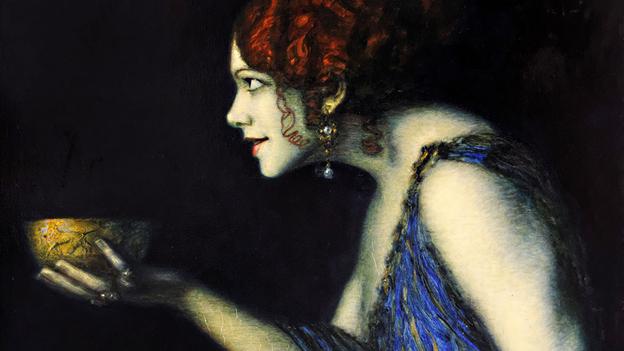
|
Images of alluring young witches and hideous hags have been around for centuries – but what do they mean? Alastair Sooke investigates. Ask any Western child to draw a witch, and the chances are that he or she will come up with something familiar: most likely a hook-nosed hag wearing a pointy hat, riding a broomstick or stirring a cauldron. But where did this image come from? The answer is more arresting and complex than you might think, as I discovered last week when I visited Witches and Wicked Bodies, a new exhibition at the British Museum in London that explores the iconography of witchcraft. Witches have a long and elaborate history. Their forerunners appear in the Bible, in the story of King Saul consulting the so-called Witch of Endor. They also crop up in the classical era in the form of winged harpies and screech-owl-like “strixes” – frightening flying creatures that fed on the flesh of babies. Circe, the enchantress from Greek mythology, was a sort of witch, able to transform her enemies into swine. So was her niece Medea. The ancient world, then, was responsible for establishing a number of tropes that later centuries would come to associate with witches. Yet it wasn’t until the early Renaissance that our modern perception of the witch was truly formed. And one man of the period arguably did more than any other to define the way that we still imagine witches today: the German painter and printmaker Albrecht Dürer. Double trouble In a pair of hugely influential engravings, Dürer determined what would become the dual stereotype of a witch’s appearance. On the one hand, as in The Four Witches (1497), she could be young, nubile and lissom – her physical charms capable of enthralling men. On the other, as in Witch Riding Backwards on a Goat (c 1500), she could be old and hideous. The latter print presents a naked crone sitting on top of a horned goat, a symbol of the devil. She has withered, drooping dugs for breasts, her mouth is open as she shrieks spells and imprecations, and her wild, wind-blasted hair streams unnaturally in the direction of her travel (a sign of her magical powers). She is even clutching a broomstick. Here is the matriarch of the witches that we find in popular culture today. For art historians, though, the interesting question is what provided Renaissance artists with the model for this appalling vision. One theory is that Dürer and his contemporaries were inspired by the personification of Envy as conceived by the Italian artist Andrea Mantegna (c 1431-1506) in his engraving Battle of the Sea Gods. “Mantegna’s figure of Envy formed a kind of call for the Renaissance of the witch as a hideous old hag,” explains the artist and writer Deanna Petherbridge, who has co-curated the exhibition at the British Museum. “Envy was emaciated, her breasts were no longer good, which is why she was jealous of women, and she attacked babies and ate them. She often had snakes for hair.” A good example of this Envy-type of witch can be seen in an extraordinarily intense Italian print known as Lo Stregozzo (The Witch’s Procession) (c 1520). Here, a malevolent witch with open mouth, hair in turmoil and desiccated dugs clutches a steaming pot (or cauldron), and rides a fantastical, monstrous skeleton. Her right hand reaches for the head of a baby from the heap of infants at her feet. This print was produced during the ‘golden age’ of witchcraft imagery: the tumultuous 16th and 17th centuries, when vicious witch trials convulsed Europe (the peak of the witch-hunts lasted from 1550 to 1630). “Across Europe, there was the Reformation and Counter-Reformation, the Thirty Years’ War, fantastic poverty and social change,” says Petherbridge. “Even King James in his text Daemonologie [1597] was asking: why was there such a proliferation of witches? Everybody assumed it was because the world had got so foul that it was coming to an end.” As a result there was an outpouring of brutally misogynistic witchcraft imagery, with artists taking advantage of the invention of the printing press to disseminate material rapidly and widely. “Witchcraft is closely allied to the print revolution,” Petherbridge explains. Many of these prints, such as the powerful colour woodcut Witches’ Sabbath (1510) by Dürer’s pupil Hans Baldung Grien, can be seen in the British Museum’s exhibition. By the 18th Century, though, witches were no longer considered a threat. Instead they were understood as the superstitious imaginings of peasants. Still, that didn’t stop great artists such as Goya from depicting them. Los Caprichos, Goya’s collection of 80 capricious (or whimsical) etchings from 1799, uses witches as well as goblins, demons and monsters as vehicles for satire. “Goya uses witchcraft metaphorically to point out the evils of society,” says Petherbridge. “His prints are actually about social things: greed, war, the corruption of the clergy.” Broom with a view Goya did not believe in the literal reality of witches, but his prints are still among the most potent images of witchcraft ever made. Plate 68 of Los Caprichos is especially memorable: a wizened hag teaches an attractive younger witch how to fly a broomstick. Both are naked, and the print was surely meant to be salacious: the Spanish ‘volar’ (to fly) is slang for having an orgasm. Around the same time, there was a vogue among artists working in England for depicting theatrical scenes of witchcraft. The Swiss-born artist Henry Fuseli, for instance, made several versions of the famous moment when Macbeth meets the three witches for the first time on the heath. By now, though, the art of witchcraft was in decline. It lacked the strange imaginative force that had animated the genre in earlier centuries. In the 19th Century, the Pre-Raphaelites and the Symbolists were both drawn to the figure of the witch, whom they recast as a femme fatale. But their sinister seductresses arguably belong more to the realm of sexual fantasy than high art. The one constant throughout the history of the art of witchcraft is misogyny. As a woman, how does this make Petherbridge feel? “At the beginning when I was looking at these images, I was quite distressed because they are so ageist,” she says. “Of course, now I’ve stopped being shocked by them, and I think that they are saved by their excess, satire and invention. Artists were often drawn to these scenes because they offered drama. They were free to spread their wings and come up with all kinds of bizarre imagery. Yes, these scenes represent the demonisation of women. But often they are keenly linked to social critique. Witches are the scapegoats on which the evil of society is projected.”
|
令人銷魂的年輕女巫和奇丑無比的巫婆形象已有幾百年的歷史了——但這代表了什么?英國廣播公司(BBC)記者阿拉斯泰爾·蘇克(Alastair Sooke)帶你走進古老而神秘的女巫世界。 隨便叫一個西方小孩畫個女巫,結果可能都差不多:鷹鉤鼻、尖頂帽、騎著個掃帚或攪著個大鍋。但這些形象又從何而來?答案可能比你想的更有趣,也更復雜。上周,我去了大英博物館參觀一個主題展——女巫和邪惡軀體(Witches and Wicked Bodies),領略了巫術的肖像學。 女巫的歷史可以追溯到很久以前。她們祖先曾出現在掃羅王求教死靈師因達爾(Witch of Endor)的圣經故事中。她們還以帶翼的鷹身女妖形象和夜間發出凄厲鳴叫的灰林鸮(strixes)形象出現在古典時期。傳言灰林鸮是一種以獵食嬰兒為主的猛禽。 喀耳刻(Circe)是希臘神話的女神,從某種程度上看,也算半個女巫。她能把敵人都變成豬。他的侄女美狄亞(Medea)也能做到這一點。看來,古老世界要對此后數百年人們以女巫形象作比喻負責。 直到文藝復興早期,現代的女巫觀才正式形成。而當時有一個人,他對女巫形象塑造之深大概無人能敵,他就是德國畫家、版畫家阿爾布雷特·丟勒(Albrecht Dürer) 雙重麻煩 丟勒的兩幅雕刻品,讓女巫的形象深入人心。他1497年的作品《四女巫》(The Four Witches)告訴我們,女巫可以是體態輕盈的妙齡女郎,其外貌足以稱得上是男性殺手。而另一方面,丟勒于1500年左右創作的作品《倒騎在山羊上的女巫》(Witch Riding backwards on a Goat)又呈現了另一種老態龍鐘的丑巫婆形象。 后來的版畫塑造了一個倒坐在有角山羊背上的裸體老太婆形象,她代表了邪惡。她的乳房干癟下垂,尖叫符咒時張開大嘴。她那亂糟糟的頭發逆風向后飄起(象征了她的魔力),甚至手里還握著個帚柄。這也是今天大眾文化中典型女巫的形象的原型。 對藝術史學家來說,人們更想知道,又是什么使得文藝復興時期的藝術家能創作出如此駭人形象。有一種說法是,意大利藝術家安德里亞·蒙塔納(Andrea Mantegna)于1431-1506年左右創作的《海神之戰》(Battle of the Sea Gods)中對“嫉妒”的擬人化手法,給丟勒及其同時代畫家帶去了靈感。 作為該展覽負責人之一,藝術家兼作家的迪安娜·佩西布里奇(Deanna Petherbridge)解釋道:“蒙塔納手中的恩維(Envy)多少影響了文藝復興時期對女巫又老又丑的形象定位。由于自身瘦骨嶙峋,胸部松弛下垂,因而對女性心生嫉妒。她襲擊嬰兒,并吃掉他們,還經常以蛇為發。” 嫉妒類女巫的典例可以在意大利名作《女巫集會》(意大利名:Lo Stregozzo,英文名The Witch’s Procession,時間:約1520年)中找到。它刻畫了一個張著大口的邪惡女巫,頭發亂七八糟、胸部干癟,抓著個大汽鍋,騎著荒誕怪異的巨型骨架。她腳踩成堆嬰兒尸骸,伸出右手要去抓其中一個腦袋。 該版畫創作于巫術意象的“黃金時期”。16、17世紀的歐洲,社會動蕩,邪惡女巫的形象在歐洲大陸引發巨大反響(獵巫的極盛時期是在1550至1630年)。佩西布里奇說道:“整個歐洲,一會兒是宗教改革、一會兒是反宗教改革,還有三十年戰爭,不可思議的貧窮和社會變革愈演愈烈。”她還說:“就連英國國王詹姆斯一世都在他的《惡魔研究》(Daemonologie)中問道:為什么女巫會越來越多?每個人都以為是因為世界已經到了無可救藥的地步,即將滅亡。” 許多歧視婦女的巫術意象因而大量涌現。加上印刷機的發明,藝術家更是借力將信息傳播開來。佩西布里奇解釋道:“巫術與印刷業變革息息相關,”其中很多作品都可以在大英博物館的展覽上看到,包括由丟勒學生漢斯·巴爾東·格里恩(Hans Baldung Grien)于1510年創作的彩色木版畫《女巫的安息日》(Witches’ Sabbath)。 雖然到了18世紀,人們不再視女巫為威脅,認為她們就是農民腦中的空想,但還是無法阻擋像戈雅(Goya)這樣的大藝術家繼續描繪女巫。 《奇想集》(Los Caprichos)是戈雅于1799年開始創作的80幅荒誕古怪版畫集,以女巫、小妖、魔鬼、怪物為載體進行諷刺。佩西布里奇說:“戈雅借巫術披露社會邪惡,他的版畫實則關系社會萬象:貪婪、戰爭、牧師腐敗。” 社會邪惡的替罪羊 雖然戈雅并不相信世界上真有女巫,但他的巫術版畫仍最具影響。《奇想集》的第68幅作品尤為突出:一位干瘦的老巫婆要教一個俊俏的小女巫如何騎掃帚。兩個人都是赤身裸體,而版畫本身也可謂淫蕩:西語的“volar”(飛翔)是來性高潮的俚語。 同時,英格蘭的藝術工作者都時興描繪巫術的夸張場面。比如:瑞士出生的藝術家亨利·富塞利(Henry Fuseli)就描繪了麥克白第一次在荒野上見到三女巫的幾個著名場景。 盡管,如今的巫術藝術在走下坡。它少了早些時候能給流派帶去鮮活生命的奇幻力量。19世紀,前拉斐爾派和象征主義都迷戀上女巫形象,重新將其塑造為蛇蝎美人。但這狐貍精形象大概更多停留在性幻想層面,而非高雅藝術。 巫術的藝術史常常是歧視女性的。那作為一名女性,佩西布里奇又作何感受?她表示:“一開始,我看著這些形象還挺痛心的,感覺他們都有年齡歧視。而現在,我不會再被嚇到,我也覺得正是作品的夸張、諷刺和創作,賦予了女巫形象另一種內涵。而正是因為這種戲劇性,藝術家才常常為這些場景所吸引。他們能放得開,想出各種怪異形象。無可否認,這些形象的確妖魔化了女性,但她們也常常和社會批評聯系在一起。女巫實際上是社會邪惡面的替罪羊。” 掃一掃,關注微博微信
 
|
|
|
